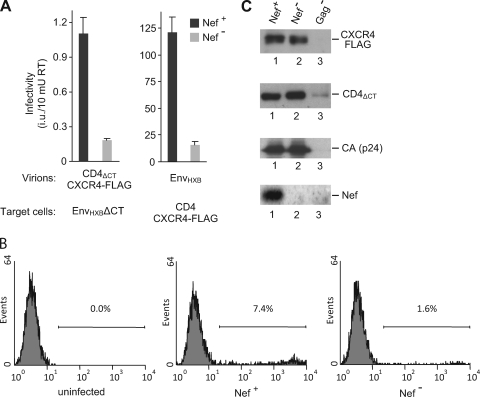FIG. 1.
Nef enhances the infectivity but not the formation of CD4-chemokine receptor pseudotypes. (A) 293T cells were transfected with HXB/Env−/Nef+ or HXB/Env−/Nef−, along with a HIV-1 vector encoding GFP and either pCD4ΔCT together with pcDNA6/CXCR4-FLAG (left) or pEnvHXB (right). Progeny virions were normalized for RT activity and used to infect HeLa cells that had been transfected with vectors expressing either EnvHXBΔCT (left), or CD4 together with CXCR4-FLAG (right). Infectivities were evaluated by counting GFP-positive foci. Values represent the average from three parallel infections, and error bars correspond to one standard deviation. (B) HeLa cells expressing EnvHXB were infected with Nef+ and Nef− CD4ΔCT/CXCR4 receptor pseudotypes produced as described for panel A, and GFP-positive infected cells were quantified by flow cytometry. The percentage of infected cells in each panel is indicated. (C) Nef does not affect the incorporation of CD4ΔCT or of CXCR4-FLAG into Env-deficient HIV-1 particles. Aliquots of the receptor-pseudotyped viruses used for the infections shown in panel A were pelleted through sucrose and analyzed by Western blotting with anti-FLAG, anti-CD4, anti-HIV-1 CA, and anti-Nef antibodies. A sample derived from cells cotransfected with pCD4ΔCT, pcDNA6/CXCR4-FLAG, and a Gag-deficient HIV-1 provirus was included as a background control.

